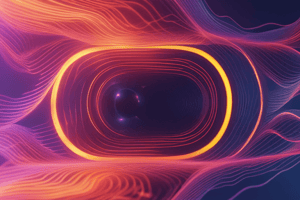Podcast
Questions and Answers
Which of the following best describes electric current?
Which of the following best describes electric current?
- The rate of flow of electric charge (correct)
- The electric potential energy per unit charge
- The total electric charge in an object
- The force exerted on a test charge
Electromagnetic waves require a medium to propagate.
Electromagnetic waves require a medium to propagate.
False (B)
What is the SI unit for measuring electric current?
What is the SI unit for measuring electric current?
ampere
The distance between two successive crests of a wave is called the ______.
The distance between two successive crests of a wave is called the ______.
Match the wave phenomenon with its description:
Match the wave phenomenon with its description:
Which of the following is true about electric charge?
Which of the following is true about electric charge?
Electric potential is a vector quantity.
Electric potential is a vector quantity.
What type of wave is sound?
What type of wave is sound?
The electric field is defined as the force per unit ______.
The electric field is defined as the force per unit ______.
What is the relationship between wave speed ($v$), frequency ($f$), and wavelength ($\lambda$)?
What is the relationship between wave speed ($v$), frequency ($f$), and wavelength ($\lambda$)?
Electric power is the rate at which electric charge flows through a circuit.
Electric power is the rate at which electric charge flows through a circuit.
What is the term for the bending of waves around obstacles?
What is the term for the bending of waves around obstacles?
In transverse waves, the displacement of the medium is ______ to the direction of propagation.
In transverse waves, the displacement of the medium is ______ to the direction of propagation.
Which of the following is an example of a mechanical wave?
Which of the following is an example of a mechanical wave?
The period of a wave is the same as its frequency.
The period of a wave is the same as its frequency.
What is the SI unit of electric potential?
What is the SI unit of electric potential?
What happens during constructive interference?
What happens during constructive interference?
Electric power is the product of voltage and ______.
Electric power is the product of voltage and ______.
The Doppler effect only applies to sound waves.
The Doppler effect only applies to sound waves.
Which of the following produces an electric field?
Which of the following produces an electric field?
Flashcards
Electricity
Electricity
The set of physical phenomena associated with the presence and motion of electric charge.
Electric Charge
Electric Charge
A fundamental conserved property of some subatomic particles that determines their electromagnetic interaction.
Electric Current
Electric Current
The rate of flow of electric charge past a point or region.
Electric Field
Electric Field
Signup and view all the flashcards
Electric Potential
Electric Potential
Signup and view all the flashcards
Electric Power
Electric Power
Signup and view all the flashcards
Wave
Wave
Signup and view all the flashcards
Mechanical Waves
Mechanical Waves
Signup and view all the flashcards
Electromagnetic Waves
Electromagnetic Waves
Signup and view all the flashcards
Wavelength
Wavelength
Signup and view all the flashcards
Frequency
Frequency
Signup and view all the flashcards
Amplitude
Amplitude
Signup and view all the flashcards
Period
Period
Signup and view all the flashcards
Reflection
Reflection
Signup and view all the flashcards
Refraction
Refraction
Signup and view all the flashcards
Diffraction
Diffraction
Signup and view all the flashcards
Interference
Interference
Signup and view all the flashcards
Superposition
Superposition
Signup and view all the flashcards
Polarization
Polarization
Signup and view all the flashcards
Doppler Effect
Doppler Effect
Signup and view all the flashcards
Study Notes
No new information has been provided. The text given is identical to the existing notes.
Studying That Suits You
Use AI to generate personalized quizzes and flashcards to suit your learning preferences.




